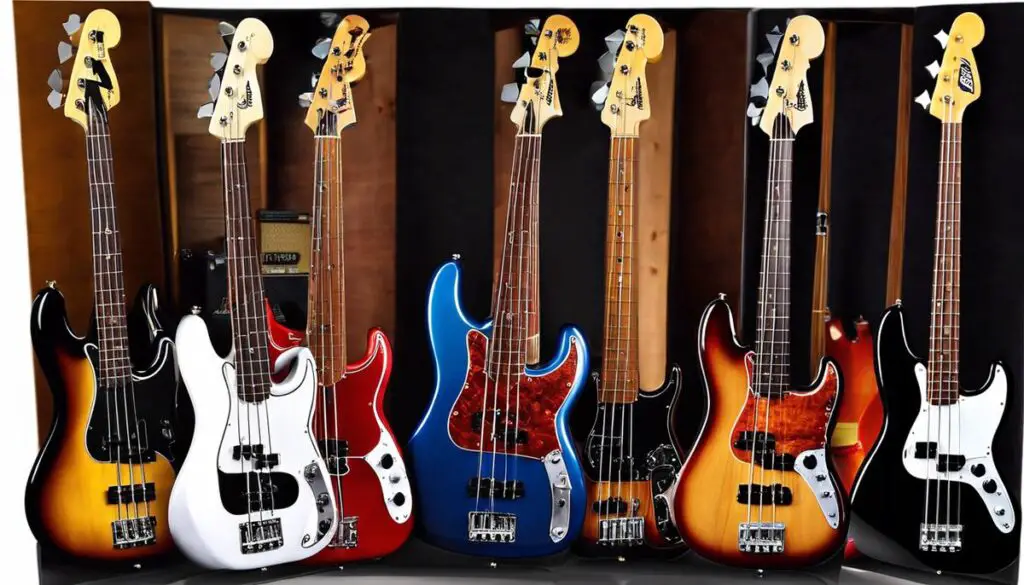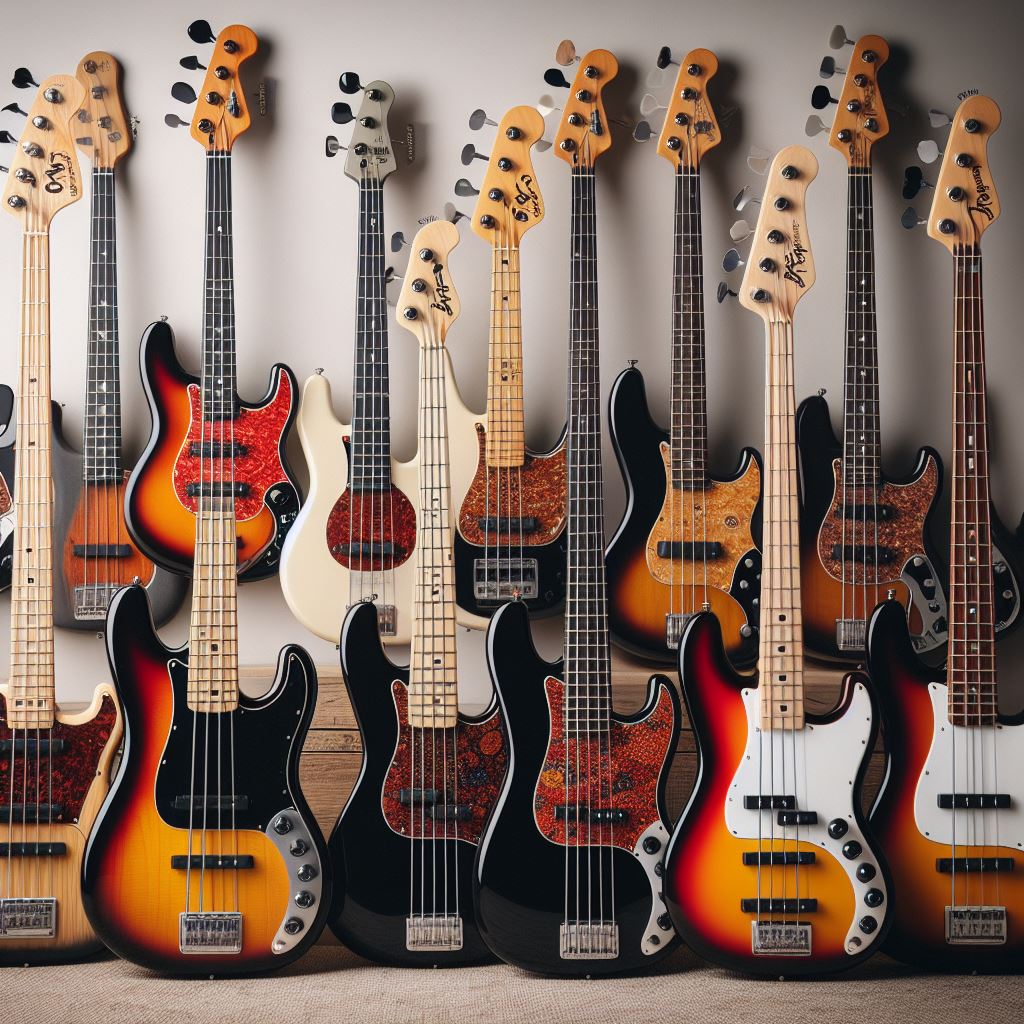The Precision Bass, fondly known as the P Bass, is a renowned musical instrument that has invigilated the music industry for decades. Synonymous with remarkable quality and a distinct, robust tone, the P Bass is adored by beginner and professional musicians alike.
This dive into the mesmerizing world of P Bass models entails a panoramic view of its history, an examination of its specifications, and a stroll through its colorful palette of popular models. Furthermore, it provides an insightful guide to choosing the right P Bass guitar tailored to meet specific needs and shares valuable tips on how to keep these marvels in optimal condition.
Table of Contents
Historical Overview of P Bass Models
Rock the Boat, Feel the Groove: The Evolution of the P Bass
Taking a ride into the world of sound can be pretty exhilarating. However, one instrument stands out among the orchestra of musical creations and has continued to evolve – the Precision Bass (P Bass). This masterpiece, which is the brainchild of Leo Fender, has transformed from a simple ’50s creation into an intricate combination of sound and beauty that resonates in the heart of any bass enthusiast.
Back to the Beginning, Welcome to the ’50s
The P Bass was born out of Leo Fender’s ingenuity in 1951. It was introduced as a prototype to replace the big, bulky, and challenging-to-use double bass. The initial model was a slab-bodied, single-coil pickup with a 20-fret one-piece maple neck and fingerboard. Its innovatively styled ‘Telecaster’ shape sported a vinyl-covered body that made it easy to play standing up.
The Transition to the ’60s
By the mid-’50s, Fender had begun to refine the P Bass design, enhancing playability and comfort. The contours streamlined the body shape, fitting more naturally against the player’s body. The split-coil pickup, introduced in 1957, proved a significant improvement, effectively dodging the hum for which the single-coil pickups were notorious. This upgrade gave the P Bass a more robust, punchier tone that resonated deeply with bass enthusiasts.
The ’70s and ’80s Revolution
The ’70s and ’80s witnessed a remarkable shift in the P Bass design. A notable change was the addition of a separate fingerboard made from rosewood or maple. Other updates included a beefier bridge, a contoured neck heel, and an option for fretless models.
Furthermore, custom color options were introduced, allowing players to express their style, and the lace sensor pickups were launched, providing a crisper and more refined sound output.
Modern Times – The Ongoing Evolution
In the ’90s and beyond, the P Bass has continued to evolve yet always remains true to its iconic sound and design. Modern features include graphite-reinforced necks, active electronic systems, five-string models, and endless color and finish options.
However, the core of the P Bass remains the same as it was in the ’50s. Its emphasis on simplicity, comfort, and, above all, sound continues to guide its evolution. Today, whether played on a world tour stage or in a small local band practice, the P Bass’s unique tone and remarkable punch continue to make the room buzz, hold down the groove, and provide music lovers with a genuine and timeless sound experience.
One thing’s for sure: while the P Bass has undoubtedly evolved, it’s never lost its soul. It’s truly a testament to the genius of Leo Fender that this instrument, through all its iterations, remains a treasured staple in the world of music.
In-Depth Analysis of P Bass Specifications
The Stand-Out Specifications and Features of the Precision Bass Model
The Precision Bass—commonly known as the P Bass—is an iconic instrument with a rich history and a lineage of continuous improvements. Let’s dive into what makes this model truly a masterpiece.
Renowned for its solid body and larger, split-coil pickups, the P Bass offers a distinctly loud and clear tonal quality that profoundly satisfies the ear. The technological advancements of the 90s added even more balance and depth to the P Bass’s inherently warm and full sound.
A heavier body, often made from ash or alder, is at the heart of the P Bass design. This weighty feature contributes substantially to the instrument’s overall tonal richness and resonance. Over the years, variants using lighter woods have emerged, but many enthusiasts swear by the solid punch given by the weightier choices.
The P Bass’ neck is another defining aspect, usually made from maple and marked by its wider “C” shape. This design exudes comfort, enabling smoother transitions between frets despite its seemingly bulky nature, and is notable for providing significant tonal influence. Fans of the P Bass specifically sing praises of the neck’s satin finish, which offers a faster, slicker feel—making quick bass lines easier to execute.
The fingerboard of a P Bass typically uses either rosewood or maple, contributing to its unique tonality. Rosewood brings a warm, smooth tone, while maple provides a brighter, more articulate sound. This allows P Bass users to select a model that fits their musical style best.
Amid its simplicity is the genius of P Bass—the split-coil pickup. Providing a humbucking effect, it eradicates any unwanted electrical noise, thereby delivering a tonally balanced and more transparent sound. Featuring two halves with reverse windings around each magnetic pole, this design cancels out the 60-cycle hum, which single coil pickups often suffer from.
However, what stands out about the P Bass is its logical design progression from the 1950s model to its modern variations. Yet, the instrument’s simplicity remains ever-present. Equipped with a master volume and tone control, the P Bass allows a wide range of sounds to be sculpted with minimal fuss. Meanwhile, its enhanced hardware, such as upgraded bridges and tuners, supports better sustain and tuning stability.
The P Bass presents a historic blend of form and function—the ideal foil for any dedicated bassist. Standing the test of time, this model consistently delivers, cementing its place in the hall of fame of musical instruments.
From its specific tonal qualities to its streamlined hardware and design, the P Bass remains a cherished bass guitar among enthusiasts, and its stand-out features help assure its enduring presence from one generation of musicians to the next. Aspiring and seasoned bassists alike, the P Bass awaits you!
Popular P Bass Models
Honing in now, let’s delve into the models themselves, which have carved their niche into the hearts of countless musicians.
As we all know, every craftsman treasures specific tools, and that applies to our beloved P Bass players. Without further preamble, let’s jump into the fray, looking at these favorite models and what has endeared them to musicians.
Starting what might be considered the crown jewel of the P Bass family, we have the Fender American Professional Series Precision Bass.
The new ’63 P Bass neck profile makes this model stand out. It provides a more comfortable grip on the hand, contributing to smoother performances on stage. The V-Mod split single-coil Precision Bass pickups are also exquisitely designed to give an articulate, well-rounded tone perfect for various musical styles. It’s noteworthy to mention the high mass bridge, which enhances sustain and resonance—a big plus for any bass player.
Next up, the Fender Player Precision Bass model captures the essence of old-school design, dressing it up in a modern suit.
Keeping true to the P Bass tradition, its alder body offers rich, punchy sounds, while the single-coil pickup brings out a distinct growling quality that has endeared P Bass to rock and punk musicians. The modern “C” shaped neck with a 9.5-radius fingerboard assures comfort for any playing technique.
We can’t ignore the Classic Series ’50s Precision Bass.
This model flies high the flag of the Fender’s golden era, flashing a vintage-style split single-coil pickup that emits a ”50s-era authentic hard-hitting bass sound. Coupled with the classic maple neck and vintage-inspired color finishes, this model is a nod to the musical giants of the past while maintaining a firm grip on the present.
Let’s not forget the Fender American Elite Precision Bass, which brings more hot features to the P Bass game.
It’s equipped with a 4th generation Noiseless pickup and an onboard active 18-volt preamp—these advancements add more tonal versatility, allowing the Elite P Bass to cover a broader musical spectrum. In addition, an “Elite” compound neck profile and a newly designed contoured neck heel add more comfort and hand speed for those fast, complex bass lines.
Last but certainly not least, the Squier Classic Vibe ’70s Precision Bass brings together luxury and affordability.
This model captures the ’70s aesthetic, with a block inlay on the fingerboard and vintage tuning machines, to the sounds of its Fender-designed alnico split-coil pickup. It features a comfortable “C”-shaped neck profile, with either maple or laurel fingerboard.
In conclusion, every musician has a P Bass model that gets their strings buzzing. Each model, with its unique features and tonal variations, offers something different yet taps into the P Bass legacy’s shared pedigree. However, they all possess that iconic P Bass punch, growl, and potent basslines that have made the P Bass a steadfast companion on the world’s biggest stages for decades. Regardless of genre or era, musicians find their groove, voice, and even a reflection of their musical identity in the Precision Bass.

Fender Precision Bass History
Choosing the right P Bass guitar
Selecting the Perfect P Bass Guitar: Decisions, Decisions
Once the homework has been done and the gist of the P Bass’s rich history and laudable qualities have been thoroughly understood, comes the coveted task: choosing the ideal P Bass model explicitly tailored to one’s style, sound, and skill level.
The Scope of Choices
Highlighted by the iconic Fender American Professional Series, the range of Precision Bass models indeed boasts a variety suited to different preferences. The Fender Player Precision Bass, a classic favorite, retains that vintage feel but teems with modern playing power.
As the name suggests, the Classic Series ’50s Precision Bass reminisces the original P Bass design, transporting you back to the rock ‘n’ roll era. For those seeking a sophisticated treatment, the Fender American Elite Precision Bass delights with its advanced features and fancy price tag. Meanwhile, the Squier Classic Vibe ’70s Precision Bass wraps this diverse list by offering the classic P Bass experience at a more comfortable price point.
Unique Features and Tonal Variations
A signature punch and growl are baked into every P Bass, defining the sound. However, subtle changes in the design and features of different models bring about unique tonal variations. So, before you cash out to any bass guitar, put on those headphones or turn up the amp and feel its vibration coursing through your fingers and arms. Does it have the punch, the growl, the identical basslines P Basses are known for? Render a nod to your groovy instincts.
Buy, Play, Experiment
Remember, the P Bass you choose isn’t just an instrument; it’s an extension of your voice. What you do with it will reflect on your groove, musical identity, and, ultimately, the kind of musician you are. So, when looking to buy your next P Bass, don’t rush. Take your time. Play a few notes—experience how the instrument responds.
One of the beautiful aspects of choosing a P Bass is that there isn’t a perfect pick. These bass guitars have been loved and used by amateurs and professionals alike, suiting jazz sessions, heavy metal gigs, or bluesy tunes in a comfortable sitting room. Each Precision Bass brings something different to the table, and that’s part of the magic.
So whether you plan on indulging in the quintessential Fender American Professional Series or the economical Squier Classic Vibe ’70s Precision Bass, let your personal preferences and styles be your guide. After all, music isn’t one-size-fits-all; it’s as diverse and individual as the players behind the instruments. Never forget your part in the legacy and ongoing evolution of the Precision Bass, and relish the musical journey with your chosen P Bass guitar.
Maintaining a P Bass
Keeping a P Bass in Peak Condition: Surefire Recommendations
Investing in a P Bass signifies an individual’s commitment to the rich, growling tone this legendary instrument provides. Indeed, this esteemed instrument isn’t simply an acquisition; it’s a relationship. However, any seasoned bassist will affirm that maintaining a P Bass requires consistent attention, love, and care. Here are the best recommendations for handling this musical workhorse, which will keep it in optimal condition and protect its prominent tonal qualities for years.
A crucial topic that sometimes gets overlooked is the essential cleanliness of a P Bass. Regular cleaning is a necessary routine. Fingerboards are subject to becoming dirt-encrusted due to prolonged use. Oils and dirt from our fingertips can accumulate, modifying the feel and response of the strings. Frequently wiping down the neck, body, and strings with an appropriate instrument cloth helps prevent this build-up and keeps your P Bass feeling fresh.
Keeping the bass in a case when not in use shields it from potential mishaps and dust. On that note, complex cases are a must-have for gigging musicians. They safeguard the bass from possible weather-related damages or impacts during travel. However, in less transit-heavy scenarios, a gig bag would suffice for storing the bass at home.
Another aspect often overshadowed is regular string change. Even with immaculate care, bass strings lose their brightness and resonance over time. Changing the strings on your P Bass regularly enhances the sound quality and keeps its signature tonal characteristics intact. While the frequency of swaps may differ among players depending on usage, a good rule of thumb is every 3 to 4 months.
Furthermore, be attentive to intonation. This step involves adjusting the length of the strings from the bridge to ensure the guitar is in tune along the entire length of the fretboard. If your P Bass seems to be playing out of tune even after precise tuning, it likely needs intonation. Remember, this procedure requires a certain skill level, so seek professional help if unsure.
Humidity and temperature changes can significantly impact a P Bass, causing the wood to expand or contract. This can lead to neck warping, fret buzz, or high action. A hygrometer can help monitor the moisture content in the air where the bass is stored. A room humidifier or dehumidifier can help rectify the situation if the humidity is too high or low. Additionally, avoid exposing your P Bass to direct sunlight or proximity to heat sources, as those may lead to cracking or warping.
Lastly, regular setup adjustments are crucial for maintaining a P Bass’s playability and sound. Setting up a P Bass involves adjusting the truss rod, action, pickup height, and intonation. These adjustments ensure optimal playability and tone. While the frequency of setups depends on the player’s usage and the environment, a good practice is a setup every six months.

Maintaining a P Bass might seem like a lot of work. But rest assured, every ounce of effort is worth it. By practicing diligent maintenance, anyone can ensure their P Bass remains a powerhouse of tone for many years. So, roll up those sleeves and begin safeguarding the remarkable legacy of your P Bass. After all, it’s not just a bass – it’s a part of you.
Embracing the P Bass is not merely about owning an instrument but about forming a symbiotic relationship with a vehicle of creativity that speaks volumes in its subtlety. The choice of a P Bass model can profoundly influence a musician’s journey, compelling the need for an informed decision. With a profusion of phenomenal P Bass models in the market, finding the one that rings true to your unique voice is thrilling.
Once you find your match, understanding how to care for it can make the difference between a fleeting affair and a lifelong partnership. The legacy of the P Bass continues to be written with every strum, in every garage, and on every stage, and it is an honor to share that story.


